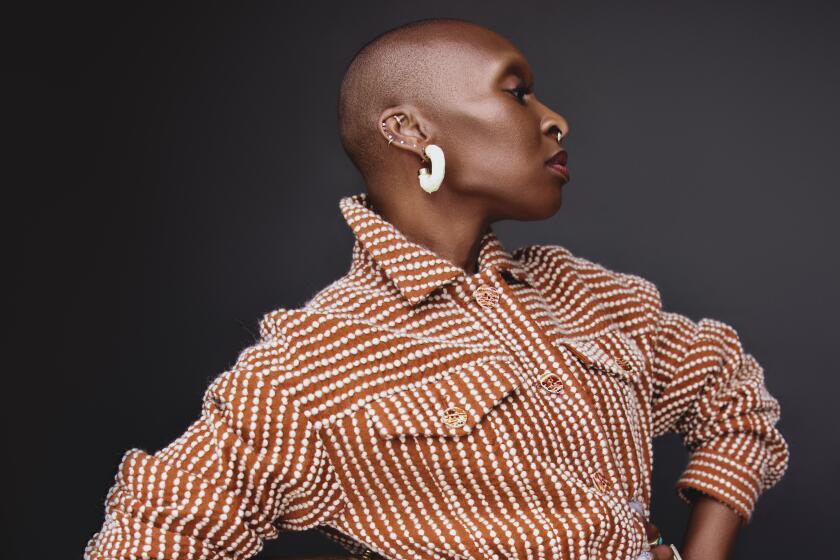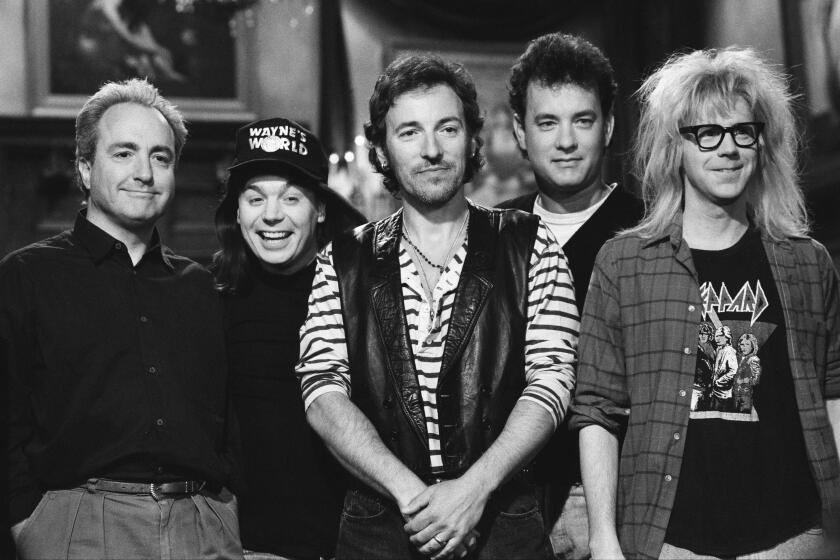FAST FORWARD: Growing Up in the Shadow of Hollywood.<i> By Lauren Greenfield</i> .<i> With an introduction by Carrie Fisher and an afterword by Richard Rodriguez</i> .<i> Alfred A. Knopf/Melcher Media: 128 pp., $35</i>
- Share via
A couple of weeks ago, I was with one of my sons in the doctor’s waiting room when a woman sashayed through the door with her kids. Casually dressed, in slacks and a sloppy T-shirt that said Katherine Hamnett on the back, she was blond, brisk, polite, obviously very composed and very attractive. The only sign that she might be someone a little bit more special was the immaculate vermilion sheen of her painted toenails; oh, and the fact that she never removed her sunglasses. As far as she was concerned she was a mother, a normal person like anyone else, trying to go about her parenting business. To me, at first, she looked like Michelle Pfeiffer. Then I realized it actually was Pfeiffer, descended from Olympus. My head turned.
It was pure L.A., a moment unique to this city, where from time to time, fantasy rears up to tantalize you, to remind you that it too can have a son with strep throat. You feel a part of it, that fantasy. It’s close enough to touch, to talk to; it’s real. This is a dangerous feeling because for a few, Los Angeles is indeed the city of dreams fulfilled, while for most, it’s a junkyard where dreams are crushed and vanish without a trace. This is a tough enough realization for adults, so imagine how it must be for kids.
Childhood is, has always been, a threatened commodity. I don’t believe that innocence is lost any earlier in Los Angeles than it was in Victorian London, where youngsters were stuffed up chimneys, or in contemporary Pakistan, where they’re sold to factory owners to stitch up leather soccer balls. But the adult world that we impose on kids in Los Angeles is perhaps unique because it’s about the difficulty of distinguishing between fantasy and reality. The movie star, the writer, the waitress, the guy just across the border, the 7-year-old on the bus--each carries his own version of the city inside him, yet so many of those visions are likely to have been influenced, soured or inspired by the entertainment industry. As photographer Lauren Greenfield writes in the introduction to her collection, “Fast Forward: Growing Up in the Shadow of Hollywood”: “Although trends come and go, especially among teenagers, I was intrigued by the role of the media as a homogenizing force. Against the foil of obvious material differences, I began to explore the ways in which young people from diverse backgrounds are similarly influenced by a popular culture they share.”
Los Angeles is--by and large--where that culture is created. Movies, TV, rap: The common language of American youth emanates from the city. Greenfield begins with her own high school, Crossroads, a private school in Santa Monica, and fans out from there. Via a linking chain of schools, proms and music, the book looks at the lives of privileged white kids in Malibu and Bel Air, at white teenagers who wish they were black and at African American and Latino near-adults, whose take on reality is smarter, tougher and more mature but no less materialistic or delusional.
“My dream is to have a black-owned record company putting out platinum hits so that any time I can say I made $20 million dollars this year,” says G-mo. “I’m a Cali boy. I want to have thangs. I want to be famous. But even more I want some ends, some money. I want to stack my money. I’m young. The sky’s the limit. In 10 years I expect to have it all sewed up.”
The kids in “Fast Forward” are obsessed with money, the flaunting of it, the spending of it, the grubbing for it. Even those wealthy enough to be able to ignore it have a near-Balzacian awareness of its significance. Its power sticks to them like something nasty oozing from the La Brea tar pits.
Adam describes his bar mitzvah: “People usually spend between 15 grand--15 being the lowest, really low--to 90 grand. I had a glassblower and carnival games, lots of them. I had a sweatshirt maker, a make-up-your-own video game. I had dancers. I had a steel drum band during the appetizers. I had fake stuffed lions and parrots. I felt really good after the bar mitzvah, and I was getting a lot of play with the girls.” At 13, he sounds like he’s already describing a good day at ICM. He’s also one of the book’s smarter and more self-aware or, at least, self-ironizing characters, also saying: “The glamorous Hollywood, the TV and movie industry--it affects kids. Who I know, who you know, how rich you are, what your dad does, what your mom does, does he work, does she work, what you have, what I have, what movies has he produced, what movie is he producing. Money affects kids in many ways. I mean, it has ruined a lot of kids I know. And not to brag--I feel it has ruined me.”
In an afterword to the book, Richard Rodriguez notes, “The children with the most interesting dilemma are the children of 90210.” I’m not sure I agree. Greenfield’s pictures dispute the point. One of her most haunting images is of Enrique, 17, the senior class president at Hollywood High School, sweating beneath the merciless Southern California sun and forking over $20 bills to pay for a limo so he can take his date to the prom. He says, “I spent close to $600. I worked hard to get the money so that prom would be at least halfway decent for me. We are from a very, very low-income family. It took me about two years to raise that much for the prom. I also got a lot of help from my mom. She’s a seamstress. She thought the money could have gone to better use, but she was supportive. It was worth it. It was wonderful. When they were announcing king and queen, even though I didn’t get it, I felt as though I had.”
The story of a poor kid trying to get money is inherently more dramatic than the story of a rich one agonizing about how to spend it, and the true tragedy of Los Angeles isn’t that it has no values or culture (it has plenty of both) but that it offers too much hope: In 1950, David Selznick said, “Hollywood’s like Egypt. Full of crumbling pyramids. It’ll never come back. It’ll just keep crumbling until finally the wind blows the last studio prop across the sands.” He was wrong--or at least only half-right. Hollywood did crumble and is crumbling still, yet it is also perpetually rearranging itself, remaining a place where great empires and fortunes can be built out of dreams of glamour. Los Angeles is a city whose fatal premise is also its most attractive quality, a siren call to boundless human optimism and gullibility.
Greenfield meets kids who are actors or who want to be actors. She captures a 12-year-old with an expression of sheer agony on her face, auditioning for the Elite Modeling Agency. There’s little Ashleigh, dressed like a Beverly Hills crocodile, already wheeling and dealing on the phone in her bedroom. There’s 12-year-old Courtney dealing blackjack at a benefit for the American Cancer Society and remarking that L.A. is the greatest place in the world to be a kid, especially if you have a pool. There’s Lindsey describing her nose job, a process apparently more grueling than a journey to the upper reaches of Borneo: “We thought that it would be simply removing the bump, but then the doctor found out there was no cartilage in the tip of my nose, so he had to do that, and my nose was too long, so he had to shorten it, and my nose was too wide, so we had to thin it.”
I defy anyone even to glance through this book and not be depressed. It made my own adolescence come back to haunt me, a time of a sinking, floundering, rootless feeling, unacknowledged at the time, filled with the fearful pressure to conform, which, in my own case, meant fiddling with safety pins attached to my anatomy and pogo-ing up and down with my arms clamped to my sides, while yodeling “no future.”
Everything changes; nothing much changes. Most teenagers are innate conservatives. Their rebellion happens, if at all, by the numbers, whether numbers are written by Elvis Presley, Jim Morrison, Johnny Rotten or Snoop Doggy Dog. In “Fast Forward,” the cry is “all now.” Even Ozzie, a 17-year-old rapper from South-Central, sounds like a wise old man when he talks about how he is raising his young daughter. On the other hand, he admits: “I’m fascinated with fame. I just want to be famous. I want to be known everywhere. I want to have that respect. . . . It’s like a fashion show. Everybody wants to be flossy. Everybody wants to be hard. Everybody wants to have power.”
Inevitably, the striving have-nots come across as more sympathetic than the grumbling haves. Another of Greenfield’s subjects, Wendy, is unhappy because upon her high school graduation, her father, a talent agency chairman and CEO, bought her a Mercedes rather than the BMW she craved. “It’s the stigma attached to a Mercedes,” she says. “It’s hard. I don’t have the same lifestyle I had when I was 14, because I can’t afford to stay at the Kahala Hilton Hotel in Hawaii and my parents aren’t going to take me anymore.”
Yikes! I guess the brutal slog of D-girldom lies ahead for Wendy. “All my friends have started out in the entertainment industry and are just figuring out that they’re not happy. It’s not fulfilling. It’s not what they thought it would be. We’re all in this total confusion. . . .”
“Fast Forward” would be tighter, deeper, more focused had it stayed on the path on which it strikes out: rich youth. The book would have been even darker, if possibly more funny, which might be why Greenfield decided to widen her sights and, in doing so, introduce a sudden change in the tone of her book. Although “Fast Forward” contains some truth, it doesn’t tell the whole Los Angeles story. Take, for example, the stunning work that New York photographer Joseph Rodriguez has done in East Los Angeles. There are plenty of kids in this city whose reality isn’t what Greenfield has recorded. Thank goodness; otherwise we really all might as well give up and move to Idaho.
More to Read
The biggest entertainment stories
Get our big stories about Hollywood, film, television, music, arts, culture and more right in your inbox as soon as they publish.
You may occasionally receive promotional content from the Los Angeles Times.










